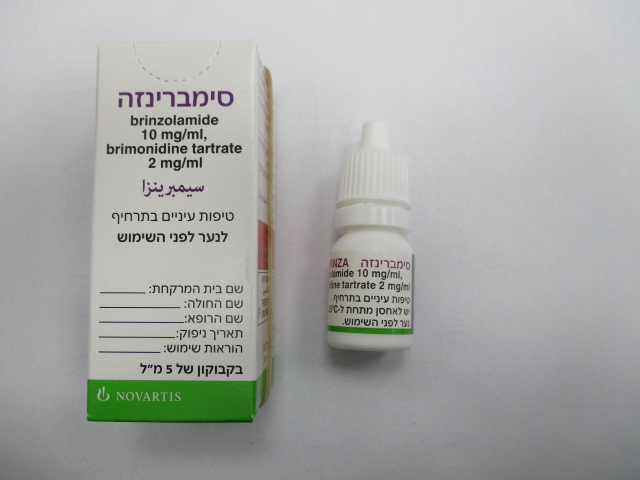Quest for the right Drug

סימברינזה SIMBRINZA (BRIMONIDINE TARTRATE, BRINZOLAMIDE)
תרופה במרשם
תרופה בסל
נרקוטיקה
ציטוטוקסיקה
צורת מתן:
עיני : OCULAR
צורת מינון:
אין פרטים : EYE DROPS, SUSPENSION
עלון לרופא
מינוניםPosology התוויות
Indications תופעות לוואי
Adverse reactions התוויות נגד
Contraindications אינטראקציות
Interactions מינון יתר
Overdose הריון/הנקה
Pregnancy & Lactation אוכלוסיות מיוחדות
Special populations תכונות פרמקולוגיות
Pharmacological properties מידע רוקחי
Pharmaceutical particulars אזהרת שימוש
Special Warning עלון לרופא
Physicians Leaflet
Interactions : אינטראקציות
4.5 Interaction with other medicinal products and other forms of interaction No specific drug interaction studies have been performed with SIMBRINZA. SIMBRINZA is contraindicated in patients receiving monoamine oxidase inhibitors and in patients on antidepressants which affect noradrenergic transmission (e.g. tricyclic antidepressants and mianserin), (see section 4.3). Tricyclic antidepressants may blunt the ocular hypotensive response of SIMBRINZA. Caution is advised due to the possibility of an additive or potentiating effect with CNS depressants (e.g. alcohol, barbiturates, opiates, sedatives or anaesthetics). No data on the level of circulating catecholamines after SIMBRINZA administration are available. However, caution is advised in patients taking medicinal products which can affect the metabolism and uptake of circulating amines (e.g. chlorpromazine, methylphenidate, reserpine, serotonin-norepinephrine reuptake inhibitors). Alpha adrenergic agonists (e.g. brimonidine tartrate), as a class, may reduce pulse and blood pressure. Following administration of SIMBRINZA, small decreases in blood pressure were observed in some patients. Caution is advised when using medicinal products such as antihypertensives and/or cardiac glycosides concomitantly with SIMBRINZA. Caution is advised when initiating (or changing the dose of) concomitant systemic medicinal products (irrespective of pharmaceutical form) which may interact with α- adrenergic agonists or interfere with their activity, i.e. agonists or antagonists of the adrenergic receptor (e.g. isoprenaline, prazosin). Brinzolamide is a carbonic anhydrase inhibitor and, although administered topically, is absorbed systemically. Acid-base disturbances have been reported with oral carbonic anhydrase inhibitors. The potential for interactions must be considered in patients receiving SIMBRINZA. There is a potential for an additive effect on the known systemic effects of carbonic anhydrase inhibition in patients receiving an oral carbonic anhydrase inhibitor and topical brinzolamide. The concomitant administration of SIMBRINZA and oral carbonic anhydrase inhibitors is not recommended. The cytochrome P-450 isozymes responsible for metabolism of brinzolamide include CYP3A4 (main), CYP2A6, CYP2B6, CYP2C8 and CYP2C9. It is expected that inhibitors of CYP3A4 such as ketoconazole, itraconazole, clotrimazole, ritonavir and troleandomycin will inhibit the metabolism of brinzolamide by CYP3A4. Caution is advised if CYP3A4 inhibitors are given concomitantly. However, accumulation of brinzolamide is unlikely as renal elimination is the major route. Brinzolamide is not an inhibitor of cytochrome P-450 isozymes.

שימוש לפי פנקס קופ''ח כללית 1994
לא צוין
תאריך הכללה מקורי בסל
12/01/2017
הגבלות
תרופה מוגבלת לרישום ע'י רופא מומחה או הגבלה אחרת
מידע נוסף
